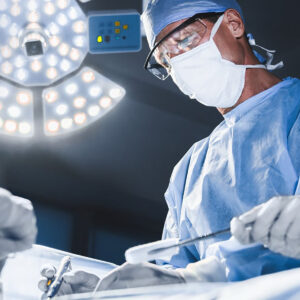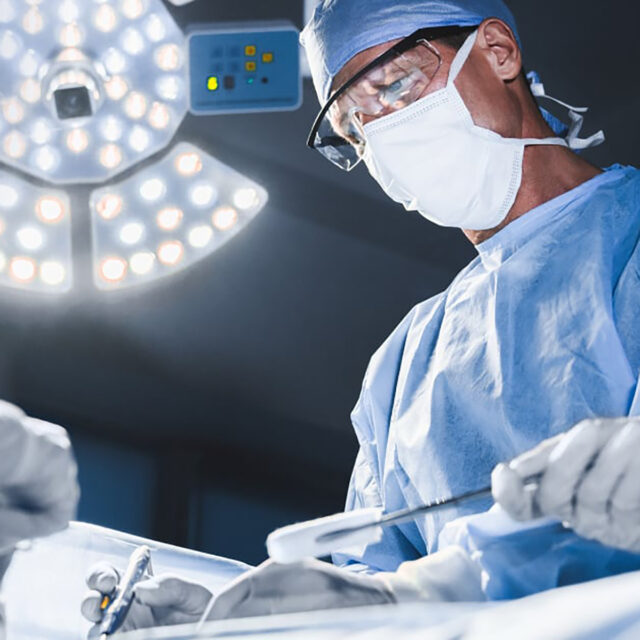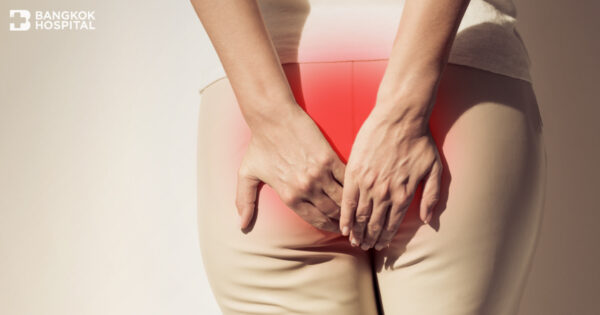Hernias occur when an organ especially small intestine protrudes through a weakened spot or tear in the abdominal wall. There are different types of hernias classified by affected area and causes. Inguinal hernia, also known as groin hernia causes a bulge or lump in the groin which is caused by fatty tissue or a part of the intestine pokes into the groin at the top of the inner thigh. Inguinal hernia is commonly caused by a combination of muscle weakness and increased abdominal pressure. Since it affects men more often than women, it is one of the health issues that largely affects athletic men who have potential risk factors such as strenuous activity, weightlifting, climbing, sit-ups and other heavy exercise.
In men aged over 60, inguinal hernia is typically caused by benign prostatic hyperplasia (BPH) due to the enlargement of prostate gland causes the strain during urination and increases an abdominal pressure. As a result, the muscles of abdominal wall become weakened and a part of small intestine protrudes through this weak area. Other contributing factors include smoking and chronic constipation which causes abdominal strain during defecation. Knowing warning signs of hernias and being aware of them are essential. If suspected signs and symptoms are noticed, early diagnosis and timely treatment must be provided as soon as possible. Not only to reduce disease severity, appropriate treatments also substantially help to prevent hernia recurrence.
Get to know inguinal hernia
Hernias occur when an organ especially small intestine protrudes through a weakened spot or tear in the abdominal wall. Hernias are commonly caused by a combination of muscle weakness and increased abdominal pressure. Hernias cause a bulge or lump in the affected area such as groin or inguinal hernia. Hernias can be particularly felt during standing up, bending down or coughing. Hernias typically flatten or disappear when they are pushed gently back into place or when patients lie down. Risk factors of hernias might include lifting heavy weights, strenuous activities, chronic cough and chronic constipation or strain during bowel movement or urination. Advanced age, being obese and smoking are also contributing factors to develop hernias.
Inguinal hernia and athletic men
Not only advanced age, other strenuous activities that increase abdominal pressure and use the strength of abdominal muscles are potential risk factors for inguinal hernia. These activities include heavy exercise, weightlifting, sit-ups and climbing. Therefore, athletic men unavoidably experience inguinal hernia, resulting in limited activities and impaired quality of life.
Groin or inguinal hernia commonly affects men aged over 40. In an early stage of inguinal hernia, a bulge or lump is presented in the area on either side of the pubic bone with pain or discomfort or burning sensation. This largely interferes daily life and normal tasks. If left untreated, bulge might become bigger and descends into the scrotum, causing pain and swelling around the testicles. Very often, patients try to push the hernia back in place which affects their confidence and personality. Many patients have to wear hernia support underwear, but it only provides temporary benefit. Protruding intestine might enlarge and progress with complications which is more challenging to successfully treat.
In elderly men, risk factor might involve difficulty urinating which is a consequence of benign prostatic hyperplasia (BPH). Due to the enlargement of prostate gland, it causes the strain during urination and increases an abdominal pressure. As a result, the muscles of abdominal wall become weakened and a part of small intestine protrudes through this weak area, presenting as a bulge or lump. Similar to those with chronic constipation, straining during bowel movement increases abdominal pressure and induces the protruding of intestine. If inguinal hernia is not treated promptly, it might eventually lead to serious complications such as incarcerated hernia. An incarcerated hernia occurs when herniated tissue becomes trapped in the weak point of the abdominal wall and cannot easily be moved back into place, As a result, it can obstruct the bowel, leading to intestinal obstruction that cuts off blood flow to part of the intestine. Incarcerated hernia is medical emergency which surgery is urgently required. If symptoms of inguinal hernia are presented, medical attention must be immediately sought.
Diagnosis of hernias
Full investigation of hernias includes:
- Medical history including past and present medical conditions
- A physical examination to check for a bulge in the groin area during standing and coughing. Abdominal palpation is usually performed to examine the protruding intestine.
- Additional imaging tests such as an abdominal ultrasound, CT scan or MRI might required if diagnosis is not readily apparent.
Treatment of hernias
Painful or enlarging hernias usually require surgical treatment to relieve discomfort and prevent other serious complications. There are two general types of hernia surgery:
- Open hernia repair
In this procedure, an incision (open cut) in the groin is made and the protruding tissue is pushed back into the abdomen. The surgeon then sews the weakened area and repair hernias. The opening is then closed with stitches, surgical glue or staples. Since it is typically done with local anesthesia, thus this surgical technique is suitable for patients with underlying diseases which are contraindicated to the use of general or spinal anesthesia.
- Minimally Invasive Surgery: Laparoscopic repair
In this minimally invasive procedure, instead of making an open cut, the surgeon operates through 3 small incisions in the abdomen. A small tube attached with a tiny camera (laparoscope) is inserted into one incision. Guided by this camera, the surgeon then inserts tiny instruments through other incisions to repair the hernia by pushing protruding tissue back in place. To enhance the strength of muscles in the abdominal wall, “synthetic mesh” will be implanted to provide additional support to weakened areas. Not only reducing the tenderness and pain after surgery, but mesh repair done by highly experienced surgeons also significantly helps minimizing the chance of hernia recurrence. Since the surgical incisions are only 5-10 mm. long, it subsequently results in minimized pain and shorter hospital stay with faster recovery time and a quick return to daily activities.
Laparoscopic totally extraperitoneal hernia repair of inguinal hernias
To achieve the best possible outcomes of inguinal hernia surgery, the expert of surgeons in laparoscopic technique plays a crucial role since the procedure involves blood vessels and a number of small nerves in the abdominal cavity. Due to the advancements in laparoscopic instrument with 4K Ultra High Definition, enables surgeons to clearly visualize the surgical field in the abdominal cavity including internal organs, blood vessels and nerves. As a consequence, it helps enhancing surgical accuracy, resulting in smaller incisions, less pain, less blood loss and reduced post-operative complications such as post-operative fibrosis or scar as well as a faster recovery time and a quick return to normal activities. Patients only require 1-2 days to be hospitalized, rather than several days required for conventional procedure.
Furthermore, lightweight synthetic mesh provides additional strength to support weakened areas with less complications. Synthetic mesh is implanted with surgical glue, also called tissue adhesive or absorbable tackers to improve biocompatibility, reduce the risk of peritoneal adhesions and reduce mid-term and long-term post-operative pain. More importantly, to effectively prevent hernia recurrences, risk factors that aggravate hernias must be strictly avoided.
Prevention
To lower risks of hernia recurrence after surgery, the recommendations include:
- Avoid heavy lifting since it increases abdominal pressure.
- Straining during urination must be avoided. Benign prostatic hyperplasia should be properly treated to improve urination.
- Chronic constipation that increases abdominal pressure should be treated. Consuming of high-fiber foods, fruits, vegetables and whole grains can help to prevent constipation and straining.
- Causes of chronic cough must be controlled e.g. common cold and smoking.
Men with particular risk factors e.g. advanced age and strenuous activities have a greater chance to develop inguinal hernia. If warning signs and symptoms such as a bulge or lump with pain or discomfort are presented, medical attention must be sought immediately. Timely and effective treatments help to prevent serious complications and minimize risks of recurrent hernias.










